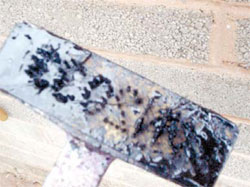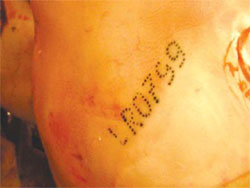



The Art of Slap Marking Slaughter Pigs
Advice on correct slap–marking of finisher pigs before they are sent for slaughter from BPEX – number 2 in its Work Instruction series.All pigs must be clearly slapmarked, with the Defra herd mark. The slapmarking can take place at a suitable stage in the production system, but must take place before the pigs are loaded. The slapmark must be legible before and after slaughter. The slapmark allows clear identification of pigs and carcases at slaughter and so provide traceability. It is the responsibility of the pig keeper to ensure that every pig being dispatched for slaughter has been clearly and correctly slapmarked.




Equipment Required
- Slapmarker plate or characters
- Tattooing ink (or paste)
- Slapmarker handle
- Inkpad
- Gloves
- Dust mask
Pre-Use Check
- Ensure the slapmarker is clean
- Ensure all of the pins are complete, straight and undamaged
- Ensure the inkpad is in suitable condition to retain a reservoir of ink
- Ensure the plate or characters are securely fixed in place
Preparation
- Clean or replace any damaged characters as necessary before use
- Test the slapmark to ensure that the correct slapmark is being used and is clear
- Set up the facilities to allow the flow of pigs to be managed, for example pigs passing in single file at a slow speed
- Ensure the area is well lit and protected from prevailing rain (wet skin = unclear marks)
- The floor area should be dry
- Ensure enough space is available to effectively slap both shoulders of each pig.
Outline of the Work
- Open the supply of tattooing ink or paste and fill the ink pad
- Ink up the slapmarker
- Slap each pig firmly and evenly, making contact squarely on both shoulders
Note: Slapping harder does not necessarily mean improved clarity. One-eighth of an inch is all that is needed to penetrate the skin. - Apply the slap in the correct place, i.e. both shoulder areas (see image)
- Reapply ink to the slapmarker on a frequent basis using the inkpad, ie after every or every other pig
- Refill the ink pad at regular intervals while in use
- If any of the pins become bent during use stop immediately and replace the damaged character or slap plate before continuing.
After Use
- Clean the slap marker thoroughly after use, for example with a wire brush in soapy water or by pressure washing
- Replace damaged slap plates immediately and replace worn ink pads
- Store in a clean, dry and secure place
- Replace the lid on the tattooing ink or paste and seal
- Wrap the inkpad in a plastic bag to prevent it from drying out.
Additional Information
The slapmark used must be the Defra herd mark specifically designated to the unit by the local Animal Health Divisional Office. The Defra herd mark is a specific combination of letters and numbers which is unique to each unit.
It is a requirement of the The Pigs (Records, Identification and Movement) Order 2007, that all pigs being moved to slaughter must be identified with their Defra herd mark. Further guidance is given to this order in New Pig Identification Rules Nov 2003. In addition to the legal requirement clear identification is also essential for the BPHS scheme, ZNCP and also grading and payment.
Pay attention to feedback from your abattoir and BPHS reports regarding the clarity of slapmarks. If either of these indicate that any slapmarks are unclear, review both slapmarking procedures and equipment. The alternative to slapmarking is the use of metal eartags or ear tattoos both of which must withstand processing of the carcass – for further information see New Pig Identification Rules Nov 2003.
Further Reading
| - | Go to our previous news item on this story by clicking here. |
February 2012









